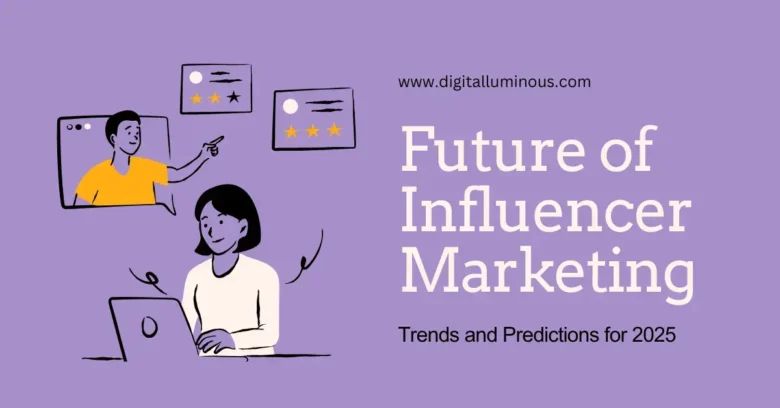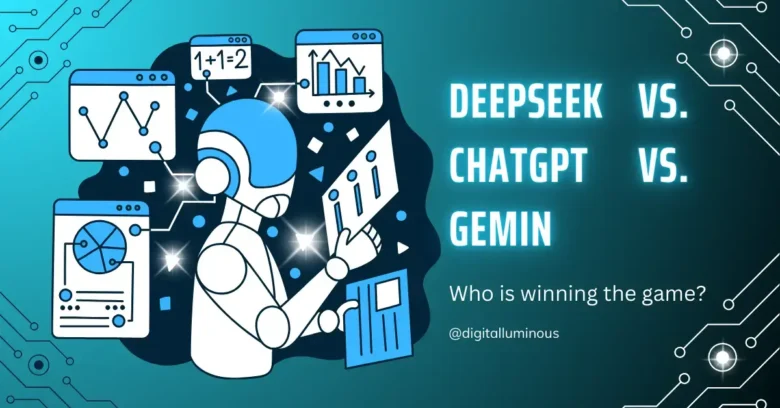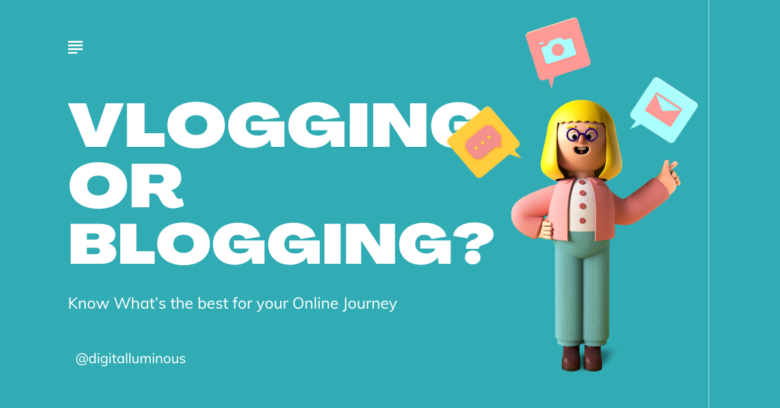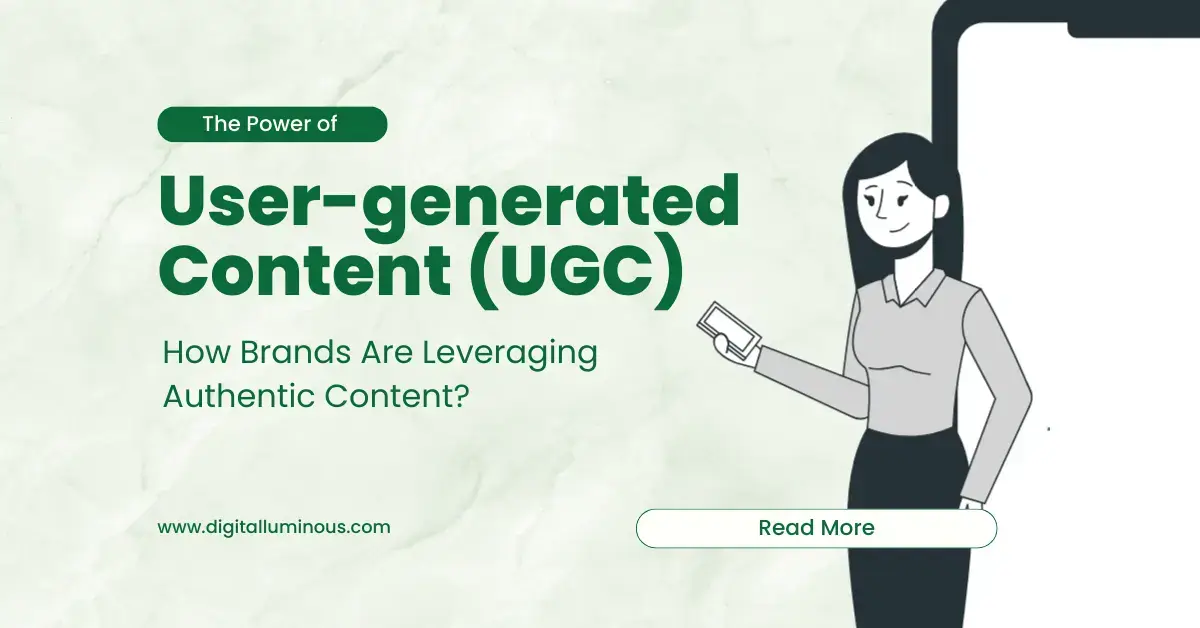
User-Generated Content (UGC) has emerged as a transformative force in digital marketing, reshaping how brands engage with their audiences.
This blog explores how UGC is being harnessed by brands to enhance their marketing strategies and drive growth.
In 2024, user-generated content (UGC) is expected to drive over 50% of all online engagement. This statistic highlights UGC’s growing importance in the digital marketing landscape.
Definition: User-Generated Content (UGC) encompasses any form of content—text, images, videos, and audio—created by users rather than professional content creators or brands.
It represents the voice of everyday people who share their experiences and opinions online.
Importance: UGC has become a cornerstone of modern marketing due to its authenticity and credibility. Consumers today are more skeptical of traditional advertising and prefer content that reflects real user experiences.
UGC provides a trustworthy alternative that helps brands build trust and foster deeper connections with their audiences.
Purpose: The goal of this blog is to explore how brands are effectively leveraging UGC to enhance their marketing efforts.
We will examine trends, benefits, strategies, and real-world case studies to illustrate the impact of UGC.
We’ll cover the rise of UGC in 2024, its benefits for brands, how brands are leveraging UGC, and best practices for its use. We’ll also present case studies and recommend tools for managing UGC.
Reasons Behind the Rise of User Generated Content in 2024

- Increased Adoption: UGC is increasingly being adopted across various industries.
For example, in the fashion industry, brands like Gymshark and Glossier leverage UGC to showcase real customers wearing their products, thereby enhancing authenticity and relatability.
- Consumer Expectations: Modern consumers are gravitating towards authentic, peer-generated content.
Studies show that 79% of people say user-generated content highly impacts their purchasing decisions. For instance, when shopping on Amazon, reviews and photos from other shoppers can heavily influence buying choices.
- Platform Evolution: Platforms that support UGC have evolved significantly.
TikTok, with its viral challenges, Instagram Stories, and Reddit threads allow users to share diverse forms of content quickly and easily. This evolution has democratized content creation, giving more people the tools to contribute.
- Growth Metrics: Statistics indicate that UGC campaigns generate six times higher engagement than traditional brand content.
For example, a campaign by the travel brand Tourism Australia saw a 50% increase in social media engagement by featuring user-submitted travel photos.
- Market Impact: UGC is influencing marketing budgets and strategies. Brands are allocating more resources to UGC-driven campaigns due to their higher ROI.
A survey by Stackla revealed that 79% of marketers believe UGC is the most effective form of content for generating brand loyalty.
Example: In 2024, Target’s #TargetRun Challenge became a hit, reflecting the rise of UGC in the United States. The campaign encouraged shoppers to share their unique shopping hauls and creative ways they use Target products on social media. This approach tapped into consumers’ desire for authenticity and community, leveraging their genuine experiences to boost engagement and brand visibility, which resulted in increased traffic and sales for Target.
Benefits of User Generated Content for Brands

- Authenticity: UGC enhances brand credibility by showcasing real customer experiences.
For instance, beauty brands like Fenty Beauty use UGC to highlight diverse customer reviews and makeup looks, building a more authentic brand image.
- Cost Efficiency: UGC is a cost-effective alternative to traditional content creation. Instead of investing in high-budget advertising, brands can utilize free content created by users.
For example, brands like GoPro rely on user-submitted videos to populate their marketing channels at minimal cost.
- Higher Engagement: UGC leads to higher engagement rates on social media and other platforms. Posts featuring UGC see up to 30% more engagement compared to branded content.
A campaign by Starbucks, encouraging customers to share their personalized drink orders, led to a significant increase in user interaction.
- Community Building: UGC fosters a sense of community and strengthens customer relationships.
Brands like Lego engage with their fan base through UGC campaigns, where users share their own Lego creations, thus nurturing a community of enthusiastic brand advocates.
- SEO and Visibility: UGC can improve a brand’s search engine rankings by providing fresh, relevant content.
For example, Yelp reviews and user-submitted photos can boost a restaurant’s visibility in local search results.
Example: Nike’s #JustDoIt Stories campaign, which invited U.S.A customers to share their personal fitness achievements and stories on social media, showcased the benefits of UGC for brands. By featuring these authentic user experiences, Nike reinforced its brand message of motivation and empowerment, leading to increased brand loyalty and engagement. The campaign not only enhanced Nike’s authenticity but also drove higher interaction and sales.
How Brands Are Leveraging UGC (User Generated Content?
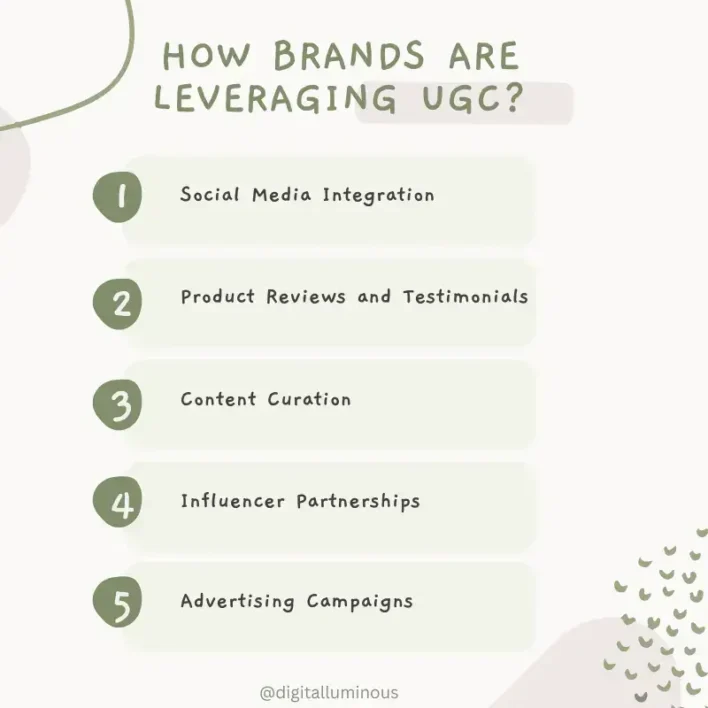
- Social Media Integration: Brands use UGC in social media campaigns by creating hashtags and challenges.
For instance, the #ShareACoke campaign by Coca-Cola encouraged users to share photos of their personalized Coke bottles, resulting in millions of user-generated posts.
- Product Reviews and Testimonials: UGC is utilized in product reviews and testimonials to build trust.
Brands like Amazon and Best Buy showcase customer reviews and ratings, which significantly influence purchasing decisions.
- Content Curation: Brands repurpose UGC for their websites, blogs, and email newsletters.
For example, Warby Parker features customer photos on their website and social media, integrating UGC into their overall content strategy.
- Influencer Partnerships: Brands collaborate with influencers to amplify UGC.
For instance, fashion brands partner with influencers to share user-generated content that features their products, reaching broader audiences and enhancing credibility.
- Advertising Campaigns: UGC is used in paid advertising campaigns to enhance authenticity.
A notable example is the use of user-submitted content in Facebook and Instagram ads, which often see higher engagement rates compared to traditional ad formats.
Example: Sephora’s #SephoraSquad campaign demonstrates how brands can effectively leverage user-generated content (UGC). The campaign invited U.S. customers to share their beauty tips and product experiences on social media using the hashtag #SephoraSquad. By featuring top posts on their website and social channels, Sephora not only showcased real customer testimonials but also created a sense of community. This approach increased brand engagement, built authenticity, and drove more traffic and sales, making it a practical way for brands to harness UGC./p>
Case Studies: How Top Brands Utilize UGC to Achieve Marketing Success
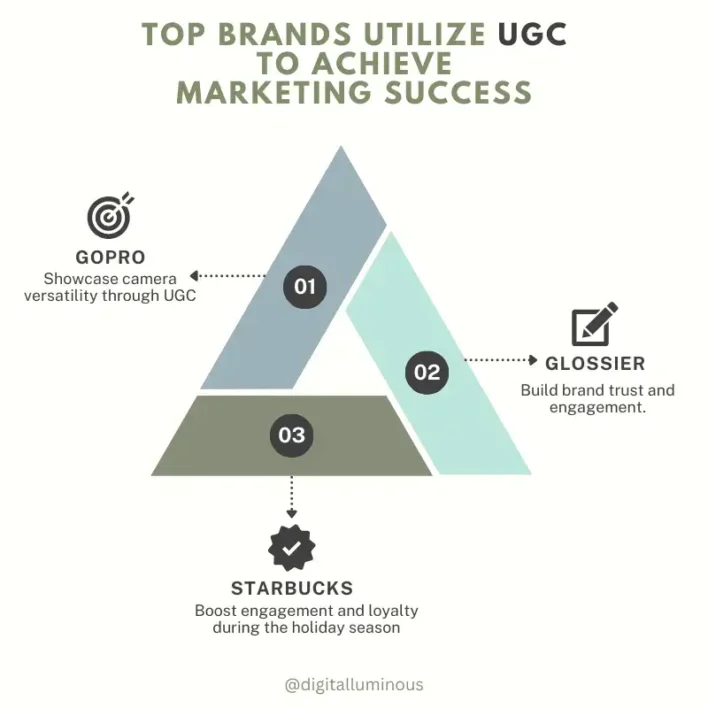
Case Study 1: Glossier
Campaign Goals: Build brand trust and engagement.
Execution: Glossier encouraged customers to share beauty routines and reviews on social media with hashtags like #Glossier and #GlossierRoutines. Featured user content on Instagram and their website.
Results: Increased user engagement and sales. Strengthened brand credibility through authentic customer experiences.
Case Study 2: GoPro
Campaign Goals: Showcase camera versatility through UGC.
Execution: GoPro featured user-submitted action videos and photos on social media and their website. Ran contests for the best content.
Results: Boosted brand visibility and engagement. Highlighted real-world applications of their cameras.
Case Study 3: Starbucks
Campaign Goals: Boost engagement and loyalty during the holiday season.
Execution: Launched the #RedCupContest, inviting customers to share photos of their festive red cups on social media. Featured user content and offered gift card prizes.
Results: Increased social media engagement and holiday sales. Strengthened customer community and brand enthusiasm.
Conclusion
User-generated content (UGC) has proven to be a powerful tool for brands in 2024, offering a genuine way to connect with audiences and enhance marketing efforts.
As demonstrated by the successes of brands like Glossier, GoPro, and Starbucks, UGC not only builds trust and credibility but also drives engagement and boosts sales. By harnessing the authentic voices of their customers, brands can create more relatable and effective marketing campaigns.
Looking ahead, the role of UGC is set to grow even more significant as technology and consumer expectations evolve.
Brands that embrace UGC and integrate it thoughtfully into their strategies will likely see continued benefits in building stronger relationships with their audiences and achieving their marketing goals.
FAQs
What is User-Generated Content (UGC)?
UGC is content created by users or customers rather than brands, including text, images, videos, and reviews shared on social media or other online platforms.
Why is User-Generated Content important for brands in 2024?
User-generated content enhances brand authenticity, builds trust, increases engagement, and is a cost-effective way to generate content and drive sales.
How can User-Generated Content improve brand authenticity?
It provides genuine, relatable content from real customers, helping build trust and credibility more effectively than traditional advertising.
What types of User-Generated Content are most effective?
Customer reviews, social media posts, unboxing videos, product photos, and personal stories on platforms like Instagram and TikTok are among the most effective types of user-generated content.
How can brands encourage customers to create User-Generated Content?
Brands can run contests, use branded hashtags, offer incentives, and create engaging campaigns that motivate customers to share their experiences.
Successful User-Generated Content campaigns in 2024:
Sephora’s #SephoraSquad campaign and Starbucks’ #RedCupContest effectively engaged customers and boosted brand visibility through user-generated content.
How can brands integrate User-Generated Content into their marketing strategies?
Brands can feature user-generated content on their websites, social media channels, email newsletters, and in advertising campaigns to enhance authenticity and engagement.
What are the benefits of using User-Generated Content over traditional content?
User-generated content is often more relatable and trustworthy, more cost-effective, and helps foster a sense of community around the brand.
How does User-Generated Content impact consumer trust and purchasing decisions?
Consumers are more likely to trust and act on recommendations from other users, making user-generated content a powerful tool for influencing purchasing decisions.
Best platforms for sharing User-Generated Content:
Instagram, TikTok, Facebook, and YouTube are popular platforms where users frequently share their experiences and content.
How can brands measure the success of their User-Generated Content campaigns?
Brands can track metrics like engagement rates, hashtag performance, website traffic, and conversion rates to assess the impact of user-generated content.
How should brands handle negative User-Generated Content?
Brands should address negative content professionally by responding promptly, offering solutions or apologies, and using the feedback to improve.
How can User-Generated Content help with SEO?
User-generated content can enhance SEO by generating fresh, relevant content, increasing engagement, and driving traffic to the brand’s website.
What tools can help manage User-Generated Content?
Tools like TINT, Yotpo, and Sprout Social help brands collect, curate, and analyze user-generated content effectively.
How can brands ensure they have the rights to use User-Generated Content?
Brands should obtain explicit permission from users before featuring their content in marketing materials and follow legal guidelines.
What are the best practices for featuring User-Generated Content on social media?
Ensure user-generated content is showcased prominently, credit the original creators, and engage with their content to build a strong community.
Trends shaping User-Generated Content in 2024
Trends include interactive content formats, integration with AI tools for content curation, and a focus on personalized customer experiences.
